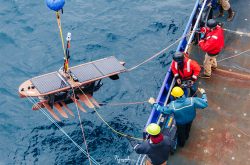
This week, a surfboard arrived in Antarctica. Not only was it missing a surfer, but the unique board was covered in parts that let it move independently and measure the surrounding seawater.
The University of Washington project will first use the Wave Glider to investigate the summer conditions near Palmer Station on the Antarctic Peninsula, to better understand how the warming ocean interacts with ice shelves that protrude from the shore.
Then in February, the cybernetic surfboard plans to head north into Drake Passage, braving some of the stormiest seas on the planet that even large research ships try to avoid. The device uses wave power to propel itself, so the monster waves common in the Antarctic Circumpolar Current can help it move forward.
“The ability to collect vertical profile data with the new winch is a game changer. It makes the platform complete as an autonomous research tool,” said James Girton, an oceanographer at the Applied Physics Laboratory and affiliate assistant professor of oceanography.
As it surfs along, the board will measure turbulence in the upper part of the Southern Ocean, which helps to measure how heat and other properties move between the water and the air. The board sends information back via satellite, and researchers will retrieve it once the mission is complete.
Read more at UW News »
